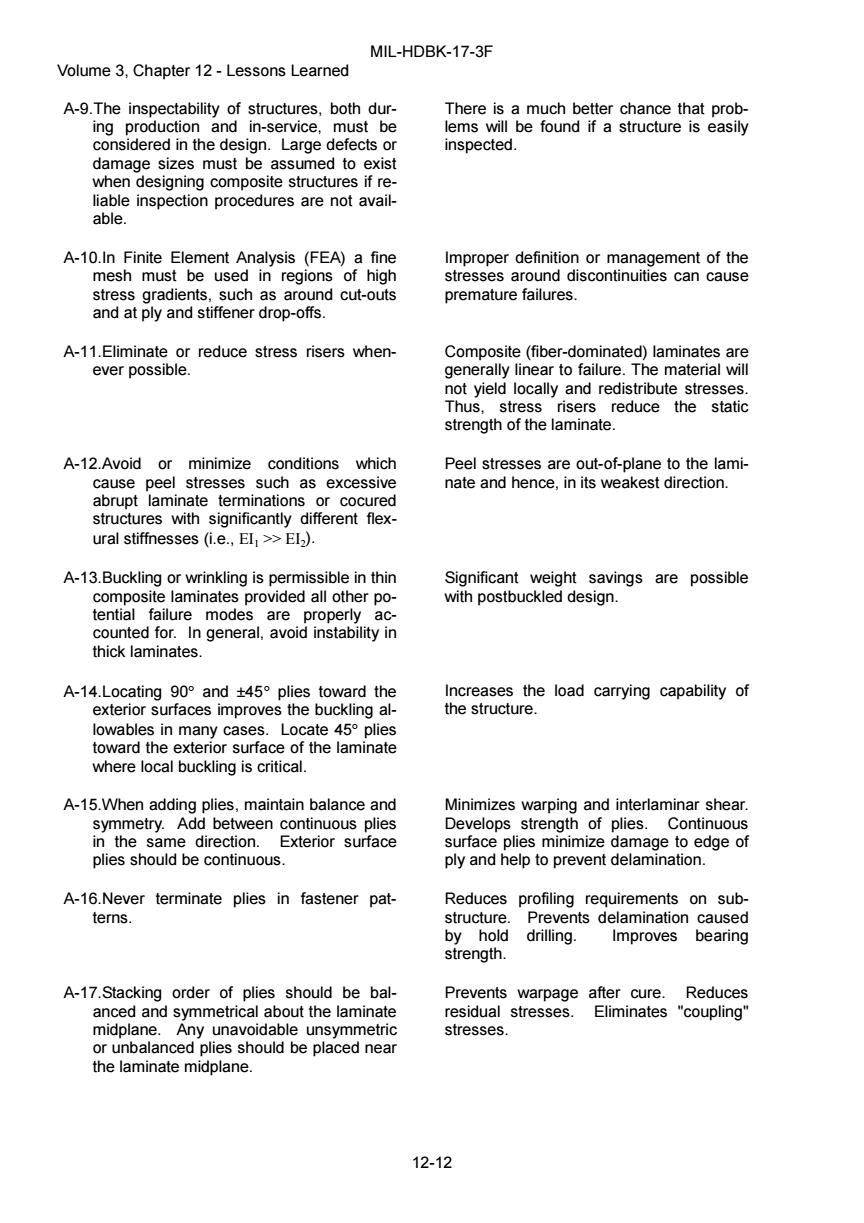正在加载图片...

MIL-HDBK-17-3F Volume 3.Chapter 12-Lessons Learned A-9.The inspectability of structures,both dur- There is a much better chance that prob- ing production and in-service,must be lems will be found if a structure is easily considered in the design.Large defects or inspected. damage sizes must be assumed to exist when designing composite structures if re- liable inspection procedures are not avail- able. A-10.In Finite Element Analysis (FEA)a fine Improper definition or management of the mesh must be used in regions of high stresses around discontinuities can cause stress gradients,such as around cut-outs premature failures. and at ply and stiffener drop-offs. A-11.Eliminate or reduce stress risers when- Composite(fiber-dominated)laminates are ever possible. generally linear to failure.The material will not yield locally and redistribute stresses. Thus.stress risers reduce the static strength of the laminate. A-12.Avoid or minimize conditions which Peel stresses are out-of-plane to the lami- cause peel stresses such as excessive nate and hence,in its weakest direction. abrupt laminate terminations or cocured structures with significantly different flex- ural stiffnesses (i.e.,EI >>EI). A-13.Buckling or wrinkling is permissible in thin Significant weight savings are possible composite laminates provided all other po- with postbuckled design. tential failure modes are properly ac- counted for.In general,avoid instability in thick laminates. A-14.Locating90°andt45°plies toward the Increases the load carrying capability of exterior surfaces improves the buckling al- the structure. lowables in many cases.Locate 45 plies toward the exterior surface of the laminate where local buckling is critical. A-15.When adding plies,maintain balance and Minimizes warping and interlaminar shear. symmetry.Add between continuous plies Develops strength of plies.Continuous in the same direction.Exterior surface surface plies minimize damage to edge of plies should be continuous. ply and help to prevent delamination. A-16.Never terminate plies in fastener pat- Reduces profiling requirements on sub- terns. structure. Prevents delamination caused by hold drilling. Improves bearing strength. A-17.Stacking order of plies should be bal- Prevents warpage after cure. Reduces anced and symmetrical about the laminate residual stresses. Eliminates "coupling" midplane.Any unavoidable unsymmetric stresses. or unbalanced plies should be placed near the laminate midplane. 12-12MIL-HDBK-17-3F Volume 3, Chapter 12 - Lessons Learned 12-12 A-9.The inspectability of structures, both during production and in-service, must be considered in the design. Large defects or damage sizes must be assumed to exist when designing composite structures if reliable inspection procedures are not available. There is a much better chance that problems will be found if a structure is easily inspected. A-10.In Finite Element Analysis (FEA) a fine mesh must be used in regions of high stress gradients, such as around cut-outs and at ply and stiffener drop-offs. Improper definition or management of the stresses around discontinuities can cause premature failures. A-11.Eliminate or reduce stress risers whenever possible. Composite (fiber-dominated) laminates are generally linear to failure. The material will not yield locally and redistribute stresses. Thus, stress risers reduce the static strength of the laminate. A-12.Avoid or minimize conditions which cause peel stresses such as excessive abrupt laminate terminations or cocured structures with significantly different flexural stiffnesses (i.e., EI1 >> EI2). Peel stresses are out-of-plane to the laminate and hence, in its weakest direction. A-13.Buckling or wrinkling is permissible in thin composite laminates provided all other potential failure modes are properly accounted for. In general, avoid instability in thick laminates. Significant weight savings are possible with postbuckled design. A-14.Locating 90° and ±45° plies toward the exterior surfaces improves the buckling allowables in many cases. Locate 45° plies toward the exterior surface of the laminate where local buckling is critical. Increases the load carrying capability of the structure. A-15.When adding plies, maintain balance and symmetry. Add between continuous plies in the same direction. Exterior surface plies should be continuous. Minimizes warping and interlaminar shear. Develops strength of plies. Continuous surface plies minimize damage to edge of ply and help to prevent delamination. A-16.Never terminate plies in fastener patterns. Reduces profiling requirements on substructure. Prevents delamination caused by hold drilling. Improves bearing strength. A-17.Stacking order of plies should be balanced and symmetrical about the laminate midplane. Any unavoidable unsymmetric or unbalanced plies should be placed near the laminate midplane. Prevents warpage after cure. Reduces residual stresses. Eliminates "coupling" stresses